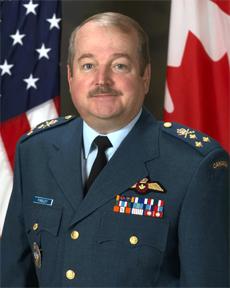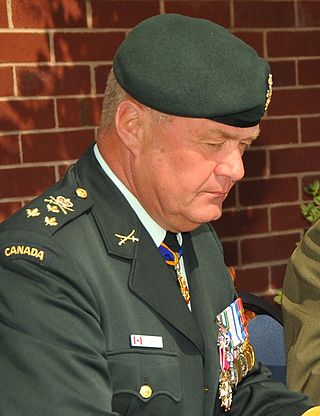Related Research Articles

The Finnish Defence Forces (FDF) (Finnish: Puolustusvoimat, Swedish: Försvarsmakten) are the military of Finland. The Finnish Defence Forces consist of the Finnish Army, the Finnish Navy, and the Finnish Air Force. In wartime, the Finnish Border Guard becomes part of the Finnish Defence Forces.

The Canadian Armed Forces are the unified military forces of Canada, including land, sea, and air commands referred to as the Canadian Army, Royal Canadian Navy, and the Royal Canadian Air Force. The CAF also operates several other commands, including the Canadian Forces Intelligence Command, the Canadian Joint Operations Command, and the Canadian Special Operations Forces Command.

The Canadian Army is the command responsible for the operational readiness of the conventional ground forces of the Canadian Armed Forces. It maintains regular forces units at bases across Canada, and is also responsible for the Army Reserve, the largest component of the Primary Reserve. The Army is headed by the concurrently held Commander of the Canadian Army and Chief of the Army Staff, who is subordinate to the Chief of the Defence Staff. The Army is also supported by 3,000 civilian employees from the civil service.

The Norwegian Armed Forces is the military organization responsible for the defence of Norway. It consists of five branches, the Norwegian Army, the Royal Norwegian Navy, which includes the Coast Guard, the Royal Norwegian Air Force, the Home Guard, and Norwegian Cyber Defence Force as well as several joint departments.

General Raymond Roland Joseph Henault, is a retired Canadian Air Force officer. He was the Chief of the Defence Staff of Canada from June 28, 2001. On November 7, 2004, Henault was voted to become the next chairman of NATO's military committee, a position he held until 2008, when he retired.
Commandant is a title often given to the officer in charge of a military training establishment or academy. This usage is common in English-speaking nations. In some countries it may be a military or police rank. It is also often used to refer to the commander of a military prison or prison camp.
Lieutenant-General (Joseph Henri Paul) Marc Caron, CMM, MSM, CD is a former Canadian soldier. Caron served as an infantry officer and Chief of the Land Staff of the Canadian Forces.

The Canadian Forces Military Police provide police, security and operational support services to the Canadian Armed Forces (CAF) and the Department of National Defence (DND) worldwide.
General Ramsey Muir Withers, CMM, CD was a Canadian Army Officer and Chief of the Defence Staff, the highest ranking position in the Canadian Forces, from 1980 to 1983. He died of a heart attack in 2014.

Andrew Brooke Leslie is a retired Canadian Forces Lieutenant-General and politician who served as the Chief of the Land Staff from 2006 to 2010 and as a Member of Parliament representing the riding of Orléans in the House of Commons, from 2015 until 2019.

The United Kingdom's Strategic Command (StratCom), previously known as Joint Forces Command (JFC), manages allocated joint capabilities from the three armed services.
The history of the Canadian Army, began when the title first came into official use in November 1940, during the Second World War, and is still used today. Although the official titles, Mobile Command, and later Land Force Command, were used from February 1968 to August 2011, "Canadian Army" continued to be unofficially used to refer to the ground forces of the Canadian Armed Forces, much as it has been from Confederation in 1867 to the present. The term was often even used in official military publications, for example in recruiting literature and the official newspaper of the Canadian Forces, The Maple Leaf. On August 16, 2011, the title, "Canadian Army", was officially restored, once again bringing the official designation in line with common and historical usage.

Lieutenant-General Eric A. "Rick" Findley, CMM, MSC, CD is a retired officer of the Canadian Forces Air Command and was the Deputy Commander of the North American Aerospace Defense Command (NORAD) from July 2003 through August 2007.
The Canadian Militia is a historical title for military units raised for the defence of Canada. The term has been used to describe sedentary militia units raised from local communities in Canada; as well as the regular army for the Province of Canada and post-confederated Canada, referred to as the active militias.

Jan Arp is a senior officer in the Canadian Forces. Appointed in January 2007, he is Chief of Staff at NATO's Headquarters Supreme Allied Command Transformation.
The Australian Defence Organisation (ADO) is composed of the armed forces of the Commonwealth of Australia, the Australian Defence Force (ADF), and the Australian Public Service government department, the Department of Defence which is composed of a range of civilian support organisations.

Vice-Admiral Philip Dean McFadden, CMM, CD is a retired officer of the Canadian Forces. He was chief of the Maritime Staff from 2009 to 2011 and last to hold the post before it was renamed to commander of the Royal Canadian Navy.
Lieutenant-General Gilles-Antoine Turcot was the Commander, Mobile Command of the Canadian Forces.
Colonel André D. Gauthier OMM, CD, was a Canadian army officer, monument sculptor and designer in various materials including bronze. He also drew in oil paint, charcoal and watercolours.

Major-General David Craig Aitchison is a Canadian military officer, who most recently served as the Deputy Commanding General for Operations with US Army Alaska. He is the former Director of Army Staff and Director of Infantry for the Canadian Forces, the former Commandant of the Infantry School, and the former Commander of the Combat Training Centre. MGen Aitchison holds a Bachelor of Business Administration from the University of New Brunswick. a master's degree in Defence Studies from the Joint Command and Staff Program at the Canadian Forces College, as well as a master's degree in Military Art and Science from the United States Army School of Advanced Military Studies. Aitchison was promoted to Brigadier General, while serving as Chief of Staff for the Combined Joint Forces Land Component Command - Operation INHERENT RESOLVE (CJFLCC-OIR). He was promoted major-general in June 2020 and took command of the Canadian Defense Academy in August 2020.
References
- ↑ Henry Howell, The Territorial Army Magazine December 1981, p. 1.
- ↑ "Top Gun: Sudbury Educator Helps Lead Nation's Defence" The Sudbury Star, 28 May 2000, A7.
- ↑ Paul Mooney "Army Prepares to Change the Way It Fights" The Maple Leaf, 28 January 2004, pp. 8–9.
- ↑ "Canadian Defence and Foreign Affairs Website" (PDF). Archived from the original (PDF) on 2011-07-18. Retrieved 2010-03-16.
- ↑ Canada Gazette Vol. 141, No. 4 — January 27, 2007
- ↑ "St. Charles College Official Website". Archived from the original on 2009-10-03. Retrieved 2010-03-16.
- ↑ "Canadian Forces Website". Archived from the original on 2011-06-10. Retrieved 2010-03-16.